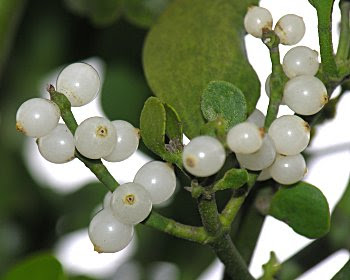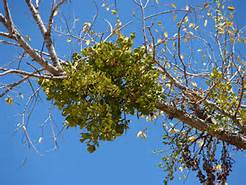RiskVA
Mistletoe – The Christmas Peace Plant 16 Dec 1998
Christmas is almost upon us, and with it comes a diverse mixture of traditions and myths, religious and ancient philosophy, food, fun, romance, and mistletoe. This Christmas parasite commonly found on oaks, hackberries, elms, and pecan trees in East Texas, is a major part of the Yuletide season. While it may be abundant here, up north people pay a premium price for a tiny sprig. Why is it so popular? Many a hopeful suitor or repentant spouse has claimed a holiday kiss under a sprig of mistletoe, and perhaps a little traditional wisdom will increase your chances for success.
Did you know that only mistletoe with berries packs any power, and with each kiss a berry must be plucked? When the berries are gone, so is the magic. No more kissing without a fresh supply. Fun? Yes, but serious business too. In some parts of England, the Christmas mistletoe sprigs are burned on Twelfth Night, otherwise all those who exchanged kisses under it are fated never to marry.
Kissing under the mistletoe may have originated with the ancient Greek festival of Saturnalia, and the plant was later used in primitive marriage rites, believing it bestowed fertility. Scandinavians viewed it as a plant of peace under which enemies could declare a truce, and angry spouses could reconcile.
The ancient Druids cut mistletoe with a gold knife at a certain phase of the moon and sent their young assistants out with its branches to announce the New Year. It was also hung in houses to bring good luck and ward off evil spirits, and over the doors of homes and stables to prevent the entrance of witches. Putting mistletoe on the ground brought bad luck! The Swiss-German name for mistletoe is Donnerbesen, or thunder-broom, since it was thought that it came to a tree in a flash of lightning. Perhaps because of this myth, it was also believed to protect homes from fire.
Over the centuries, and around the world, mistletoe has gradually become associated with Christianity. In Brittany, the plant is called Herbe de la Croix, or the cross plant, because an ancient legend says the cross on which Christ was crucified was made of mistletoe. As punishment, it was condemned to forever be a parasite.
The English name “mistletoe” comes from a combination and slight modification of the old Anglo-Saxon words “mistel,” meaning dung, and “tan,” for twig; in other words, “dung twig,” because until the 1600s mistletoe was believed to magically appear from bird droppings scattered on tree limbs. However, it was soon discovered that when birds ate mistletoe berries, the seeds simply passed through their digestive tract unharmed and, you know birds! Splat! Another potential sprig of mistletoe appeared on a branch in a white splash mark. Not so mysterious after all! Mistletoe berries also contain a sticky mucilage and birds eating them get seeds stuck on the outside of their beaks. Never known for table manners, and short on napkins, they just rub their gummed up faces on a nearby branch to clean off the seeds, leaving them stuck there. Later, these seeds, as well as those in the droppings, sprout, push a special root-like probe into their host, and begin to absorb nutrients, sometimes causing serious problems for the tree. Although it has chlorophyll and can manufacture some of its own food, mistletoe is a parasite, and like some people, it would rather drain its host’s energy instead of doing its own work.
Mistletoe is poisonous to humans, containing substances that affect the nervous system. Be careful that it’s placed out of the reach of children. The berries may look enticing, but swallowing the leaves, stems, or berries can cause nausea and vomiting. At the same time, mistletoe has, since ancient times, been used medicinally. The Druids called it “all-heal” in the belief that it was a panacea and could cure any disease. Nice idea, but not true. However, during the 16th and 17th centuries it was used, with at least some success, in the treatment of neurological illness such as epilepsy and other convulsive disorders, hysteria, heart disease, and urinary dysfunction.
Like the complexity of the Christmas Season itself, this little plant has become interwoven with our lives in diverse and amazing ways.
So, as the legends say, may your Christmas Season be free of fire, blessed by fertility, health, and good luck, and a time of love, peace, and reconciliation, at least partly due to a humble globe of green branchlets clinging to winter’s leafless trees.
Dr. Risk is a professor emeritus in the College of Forestry and Agriculture at Stephen F. Austin State University in Nacogdoches, Texas. Content © Paul H. Risk, Ph.D. All rights reserved, except where otherwise noted. Click paulrisk2@gmail.com to send questions, comments, or request permission for use.


